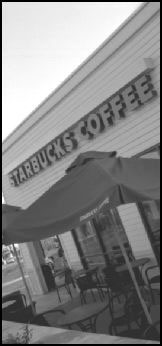TWO YEARS AGO, when CEO Howard Schultz uttered the words “Starbucks” and “Internet” in the same breath, his company’s stock dropped 25 percent, and he quickly backpedaled. The coffee brewer’s latest venture in cyberspace, announced in January and launching in May and June, avoids a scalding by shouting “partnership” and whispering “Internet.”
I’ve been waiting with decaf Americano-tinged breath for the appearance of this promised new high-speed wireless network that Starbucks is installing— excuse me, partnering with a Texas firm, MobileStar, to install. The network will eventually appear in most of Starbucks’ North American outlets, ultimately reaching 4,000 stores over the next two years. Compaq and Microsoft also have their stirrers in the mocha, mixing in equipment and content.
But Starbucks has kept mum, revealing only that Seattle, Dallas, and San Francisco will be the first cities to be “unwired.” In recent weeks, I and fellow obsessed enthusiasts of wireless networks have dowsed for signal while wiping the foam off our lips, and tried to worm information out of baristas.
What’s publicly known is that the standard that MobileStar is putting into Starbucks shops has the techie moniker IEEE 802.11b. It’s better known as AirPort to Mac owners and Wi-Fi (“wireless fidelity”) to the rest of the world, a name promoted by a trade group. It’s all the same, and it’s platform-to-platform compatible. With a laptop equipped with a Wi-Fi card, you can scan for and connect to public networks.
A Wi-Fi network runs at up to 11 megabits per second via a central access point, even with walls, people, and furniture obstructing the signal. The access point is connected to a wired Net connection at any speed; Starbucks plans 1.544 Mbps. Indoors, you might reliably stray between 50 and 150 feet from the central point; outdoors, with a line-of-sight, fellow addicts have reported well over a thousand feet.
More and more public places are unwiring, including Sea-Tac and other airports, restaurants, and conference centers. San Francisco-based Surf and Sip (www.surfandsip.com) has specialized in finding independent outlets near dense retail hubs to take advantage of Wi-Fi’s range: You can sit at Starbucks, Tully’s, or Royal Grounds and use a nearby wireless network. Tenzing Communications here in Seattle is even testing Wi-Fi networks for in-flight use.
Many self-employed folk, telecommuters, and road warriors find themselves away from the bandwidth hose at which they love to suck, and have to change behavior and become much less efficient when handling routine e-mail, accessing company resources, or simply playing networked Doom.
With Wi-Fi and similar, faster technologies coming down the pipe, the network is everywhere. Waiting for a plane at Sea-Tac, sucking some joe, sitting in the park: OK, maybe you don’t have to work all the time. But the combination of high-speed, wireless, and everywhere offers control over the time and place of your work and play.
STARBUCKS FINALLY let down its guard at a Capitol Hill outlet: The network lives—at least in test mode. Mike Daisey, the solo performer behind the recently closed and soon-to-tour 21 Dog Years: Doing Time @ Amazon.com, knew of my id饠fixe. He uses an AirPort-equipped Apple Titanium PowerBook as part of his performance and his home wireless network, and himself trolls for Wi-Fi networks.
He wrote to me in e-mail, “Please be aware that the Starbucks on E. John on Capitol Hill has AirPort enabled and running—I’m sending this from there.” A Starbucks spokesperson politely deflects requests for elaboration or timetables, but the company’s partners have been more forthcoming.
MobileStar’s chief technology officer, Ali Tabassi, says that Dallas Starbucks outlets should get turned on for real by this week, in perhaps the only case of Dallas beating Seattle in adopting technology. Tabassi says that 300 stores are ready to roll, with Seattle in early June, followed by San Francisco later that month. New York and Houston are next, but not scheduled. (New York has been oddly behind the times, with almost no Wi-Fi access.)
MobileStar charges a variable rate based on usage. Charges range from $2.50 for 15 minutes (and 10 cents per additional minute) up to $60 per month for unlimited national access. Tabassi says that in conjunction with the Starbucks launch, MobileStar will add a $20 per month regional unlimited plan.
Many news sources misreported that Compaq itself was displacing MobileStar as the wireless provider. Starbucks may have added to the confusion by their characterization of Compaq, which a Starbucks spokesperson describes in a series of buzzwords as the “preferred information technology provider for our retail stores and our headquarters.”
Compaq spokesperson Dayna Fried explains that while MobileStar would offer the network, Compaq would be providing computers and handhelds. Fried said that the in-store details have yet to be finalized, but could include rental, sale, or free use of the computer maker’s iPaq PocketPC handheld with wireless access. Compaq may also make wireless cards and related technology for sale in the stores.
Starbucks’ warm, silent embrace of wireless networking fills me and my wireless-dowsing friends with joy. Perhaps I can toss my collection of phone cords and adapters from my traveling bag at last. But I do see one drawback: The computer campers who currently treat Starbucks as their home office may never leave.





